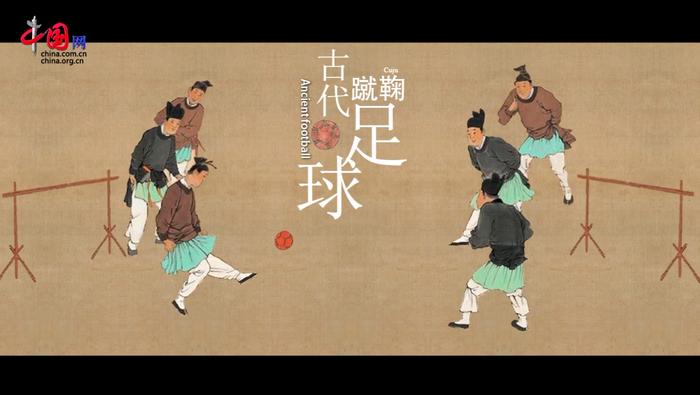中轴线之赛:古人也开运动会!
发布时间:2023-11-16

从2008到2022,北京成为世界上第一个“双奥之城”,鸟巢、水立方(冰立方)等随之成为世界瞩目的体育文化景观,它们所处的位置正是在北京中轴线的延长线上——事实上,古代中国的很多体育运动是以中轴线为中心开展的,如今很多现代体育项目中也能看到中国古代体育的影子。
It just took 15 years from 2008 to 2022 for Beijingto become the world's first city to host both the Summer and Winter Olympics, creating world-famous sports and cultural landscapes such as the Bird's Nest and Water Cube (Ice Cube), which are located on the extension lineof Beijing's Central Axis.
In fact, many sports in ancient China were carriedout around the Central Axis, whose traces could still be spotted in many modern sports today.

古代花样滑冰——冰嬉
Ancient figure skating--Icefrolicking
冰嬉是众多冰上活动的统称,挑选擅长溜冰者加以训练,在太液池进行表演,尤其是其中的“花样滑冰”和“冰上杂技”最为精彩。故宫博物院收藏的《冰嬉图》描绘的就是乾隆时期宫廷冰嬉的盛大场面。
Ice frolicking is a general term for many ice activities. Those who were good at skating were selected to train and perform in Taiye Poolin the Forbidden City, presenting impressive performances like figure skating and acrobatics on ice. The Frolic on the Ice, a painting collected by the Palace Museum, depicts the grand scene of ice frolicking in the imperialcourt during the period under Emperor Qianlong’s reign (1736-1796).

古代速度滑冰——抢等
Ancient speed skating—Running for rank
抢等也是冰嬉中的一种活动,类似于冬奥项目中的速度滑冰。
Running for rank was also an ice frolicking activity, which was similar to speed skating in Winter Olympics.

古代足球——蹴鞠
Ancient football -- Cuju
如今足球运动风靡世界,2004年国际足联认定“中国是足球运动的发源地”。足球在中国古代称为蹴鞠,“蹴”是踢的意思,“鞠”是指革制的皮球。在清朝,蹴鞠是宫廷节庆的节目之一,在民间同样十分普及。后来,蹴鞠传入欧洲,经过了长时间的发展逐渐完善,渐渐地形成了现代足球。
Nowadays, football is popular all over the world.In 2004, FIFA recognized that China is the birthplace of football. Football was called cuju in ancient China. The Chinese character “Cu” means kicking, and “Ju” refers to leather ball. In the Qing Dynasty, cuju wasone of the festive activities of the court, and it was also very popular outside the court. Cuju was later introduced to Europe, and gradually became modern football after a long period of development and improvement.

古代马球——击鞠
Ancient polo -- Jiju
如果说蹴鞠是一项脚上运动,那么击鞠则是手脚并用。在马上击球,人既要驭马,又要挥杆,极其讲究个人技术。
If cuju was a foot sport, then jiju was a sport entailing thecombined skills of hands and feet. When hitting the ball on a horse, the player should not only control the horse, but also swing a bat to hit the ball, demanding quite sophisticated personal skills.

古代高尔夫球——捶丸
Ancient golf -- Chuiwan
比起蹴鞠和击鞠,捶丸则是偏柔和的一种体育运动。它与现代的高尔夫球十分类似,参赛者手持球棒依次上场击球,球窝处会插有彩旗作为标识,打进球窝即可得分。
Compared with cuju and jiju, Chui Wan was a softer sport. It was very similar to modern golf. Players would hold bats and hit the ball in turn. Colorfulflags would be inserted at the socket as signs, and a score could be gained if the ball was hit into the socket.

古代马拉松——放走
Ancient marathon--Fangzou
比第一届现代奥运会早六百年的中国元朝,每年会举行一次长跑比赛,称为“放走”。与今天全球流行的城市马拉松一样,“放走”的地点也是在当时元朝的两个都城,而它的长度则几乎相当于两个马拉松。
In the Yuan Dynasty, 600 years before the first modern Olympic Games, a long-distance race called fangzou was held once a year. Like today’s popular city marathon in the world, fangzou was alsoheld in the two capital cities of Yuan Dynasty at that time, and its length was almost equivalent to two marathons.
经历历史的变迁,体育项目的规则和名称在变,但是人们热爱体育的心却没有变。截至2021年底,中国户外运动参与人数超过4亿人次,不同种类的户外运动项目层出不穷;截至2022年底,中国健身步道共计12.78万个,全国冰雪运动场地2452个。新的体育场馆延展了中轴线的内涵,体育项目也从少数人的娱乐走向了广大的民间。
Along with the changes of time, the rules and names of sports events are ever different, but people's love for sports have remained the same. By the end of 2021, the number of outdoor sports participantsin China exceeded 400 million, with the constant emergence of different kinds of outdoor sports. By the end of 2022, China was home to 127,800 fitness trails and 2,452 ice and snow sports venues. The new stadiums have extendedthe confinement of the Central Axis, and various sports events have developed from the entertainment of a few people to shared fun by the general public.
.
9001354
客户端中查看
手机中查看
分享


